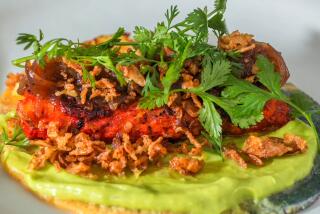At Rivera, modern takes on classic Latin dishes — taco cart optional

- Share via
In my continuing obsession with the evolution of Latin foods in America, I’ve noticed that the latest rage has been dining on demand, a merger of traditional cooking and fast food. And I don’t mean Taco Bell’s widely advertised new breakfast menu.
The way I see it, the familiar taco truck — long a fixture on L.A. streets and the padrón of the new super-trendy gourmet food truck — has crashed through the restaurant wall. Diners more often now want to order a bunch of food, appetizers and main courses alike, have it arrive all at once and share like mad.
At Rivera, we recently launched our own version of loncheras, the old-fashioned term for taco carts. But my smaller loncheras, which can be pushed easily among the restaurant’s tables, are anything but old-fashioned. They’re beautifully designed objects in their own right, but more important is the food, which is modern takes on traditional Latin dishes like tacos and tamales.
What my kitchen team and I have done is to strip the traditions down to their essence and then reinterpret them in surprising new ways. And the principles behind those reinterpretations are something you can do in your own home kitchen, even if you don’t have a fancy new cart.
Take these pastrami tacos. They’re crispy fried blue-corn taco shells that we stuff with sauerkraut, pastrami and a smear of ballpark mustard, then top with sliced pickled jalapeño — all ingredients you can find in your local market (though you may have to sub yellow corn tortillas for blue and make them bigger if you want).
The lesson: Feel free to go unconventional and global with your taco fillings. You could just as easily fill them with Philly cheesesteak, Southern pulled pork, French duck confit or Indian tandoori chicken, all with appropriate traditional accompaniments and garnishes.
Then there’s the acorn squash tamales, which are big enough to share, among its other dishes. The essence of any tamale is to steam cornmeal masa inside a flavorful, fragrant wrapper, which in Mexico is usually corn husks but also, particularly in Oaxaca, big squares of banana leaf. So why not use a steamed and hollowed-out whole acorn squash as the container for masa and diced roasted pork shoulder in a guajillo chile sauce?
At home, you could substitute other meat fillings, a vegetarian filling such as the diced-zucchini mixture known as calabacitas or crumbled cotija cheese or goat cheese; and you could make larger squash tamales in small hollowed-out sugar pumpkins or even larger, longer winter squashes halved lengthwise.
That’s what modern Latin cooking is all about, simultaneously respecting traditions and breaking free of their straitjackets. Just be sure to serve it up fast and all at the same time, and encourage your guests to share. That’s the lonchera spirit.
Sedlar is chef-owner of Rivera in downtown Los Angeles.
More to Read
Eat your way across L.A.
Get our weekly Tasting Notes newsletter for reviews, news and more.
You may occasionally receive promotional content from the Los Angeles Times.








